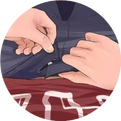1. Zhongzi Point for Chronic Back Pain, Instant Effect, No Other Point in the Fourteen Meridians Can Compare
Location: One inch below the tiger’s mouth on the palm, between the metacarpal bones of the thumb and index finger, connected to the Daba (Great White) point on the back of the hand. Anatomy: Contains the radial nerve, radial artery, and branches of the lung nerve. Needling: With the palm facing up, the point is located one inch below the space between the metacarpal bones of the thumb and index finger, which can connect to the Daba point. Meridian: Enters the Lung Meridian. Point Characteristics: Dispels wind and releases the exterior, clears lung qi. Indications: Pneumonia, lung cancer, emphysema, colds, cough, asthma, palpitations, fever reduction, laryngitis, back pain, chest pain, knee pain. Needling Method: Directly insert one to two inches. For treating pediatric conditions, using a three-edged needle to draw blood is particularly effective. Sensation: Aching and distending pain. Explanation: Zhongzi and Zhongxian points are close to the traditional fourteen meridian Lung Meridian, thus they can also treat lung-related diseases.
2. Shen Guan Point for Frequent Urination
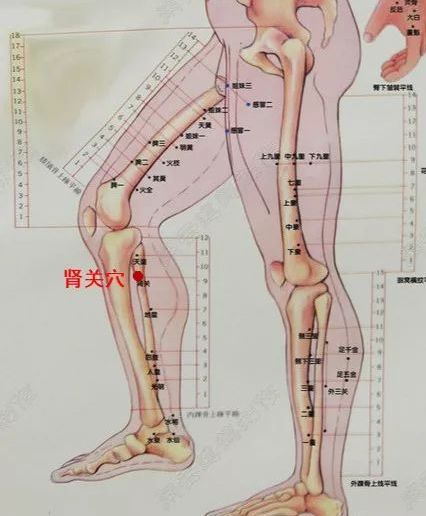
Location: Shen Guan point is located one and a half inches below the Tian Huang point.
Indications: Excessive stomach acid, gastroesophageal reflux, strabismus, astigmatism, anemia, epilepsy, neuropathy, brow pain, nasal bone pain, dizziness.
Needling Method and Application: Insert five to ten millimeters. Supplement the kidney by inserting two inches deep. For excessive stomach acid and gastroesophageal reflux, it is paired with the Tian Huang point.
3. Mu Point for Goose Foot Disease

Mu Er Point
Location: Three-tenths of an inch from the center of the first phalanx of the index finger on the palm side. This is three-tenths of an inch from the center of the middle point.
Anatomy: Contains the proper palmar digital nerve and liver nerve.
Needling: With the palm facing up, the point is located three-tenths of an inch from the center of the first phalanx of the index finger.
Meridian: Enters the Liver Meridian.
Point Characteristics: Soothes the liver, regulates qi, invigorates blood, and dispels wind.
Indications: Irritability, excessive work, shoulder tightness and pain, right flank pain, neck stiffness, high cholesterol, stomach distension and pain.
Needling Method: Use a five-millimeter needle, directly insert two to four millimeters.
Sensation: Localized aching and distending pain.
Application: Using both hands for needling yields better results.
Explanation:
(1) In the works of Dong Gong, the Mu point has a limited range of indications, while Master Hu expanded its range. Lai Zhu in his book referred to the Mu point as a cold remedy point, stating that it is effective for tearing, sweating, stopping sweating, and colds. He claimed that the Mu point can stop cold-induced runny nose in a moment. However, I believe that for treating cold-induced runny nose, it is better to combine it with the San Cha San point, Ling Gu, Daba, and add the foot cold remedy point for better results.
(2) The Mu point corresponds to the liver area in the holographic projection of human organs, hence it is called the Mu point. Therefore, using this point is particularly effective for treating right flank pain.
Mu Yi Point
Location: Two and a half inches below the center of the first phalanx of the index finger on the palm side.
Anatomy: Contains the proper palmar digital nerve and liver nerve.
Needling: With the palm facing up, the point is located two and a half inches below the Mu Er point.
Meridian: Enters the Liver, Stomach, and Lung Meridians.
Point Characteristics: Clears liver and gallbladder heat, opens up and unblocks orifices.
Indications: Bitter mouth, tinnitus, excessive liver fire, irritability, shoulder pain, right flank pain, neck stiffness, high cholesterol, stomach distension and pain.
Needling Method: Use a five-millimeter needle, directly insert two to four millimeters.
Sensation: Localized aching and distending pain.
Application: Same as Mu Yi Point.
Explanation:
(1) The depth of needling varies according to the meridian being treated. The Mu Yi, Mu Er, and Mu San points are listed by Master Hu. In Dong Gong’s book, there are two illustrations of Mu points, but only one Mu point is mentioned in the text. These three points can be treated with a five-millimeter needle, shallowly inserted one millimeter into the Lung Meridian, and deeply inserted two to four millimeters into the Liver and Stomach Meridians. This is a unique feature of Dong’s extraordinary points, and the meridian to which the needle belongs varies with the depth of insertion, which should be noted.
(2) There are three Mu points, and all three can be used together for treating right flank pain with excellent results. They are also effective for dry mouth and excessive heat.
Mu San Point
Location: Two and a half inches above the center of the first phalanx of the index finger on the palm side.
Anatomy: Contains the proper palmar digital nerve and liver nerve.
Needling: With the palm facing up, the point is located two and a half inches above the Mu Er point.
Meridian: Enters the Liver, Stomach, and Lung Meridians.
Point Characteristics: Clears liver and gallbladder heat, opens up and unblocks orifices.
Indications: Bitter mouth, tinnitus, excessive liver fire, irritability, shoulder pain, right flank pain, neck stiffness, high cholesterol, stomach distension and pain.
Needling Method: Use a five-millimeter needle, directly insert two to four millimeters.
Sensation: Localized aching and distending pain.
Application: The Mu Yi, Mu Er, and Mu San points can be used interchangeably in clinical practice. Using a three-edged needle to draw blood is particularly effective for treating gastrointestinal distension and severe flank pain. Using both hands for needling is not contraindicated.
Explanation: In Lai Zhu’s experience with the Mu point, it can treat easy tearing and dryness of the eyes. Additionally, the Mu point can stop external wind pathogens from causing skin itching, as it enters the Liver Meridian, which connects to the eyes. Therefore, as Lai Zhu stated, it can treat the above symptoms. However, I believe that if the Mu point is combined with Dong’s extraordinary upper San Huang point, the effect will be even better.
4. Gynecological Points for Infertility
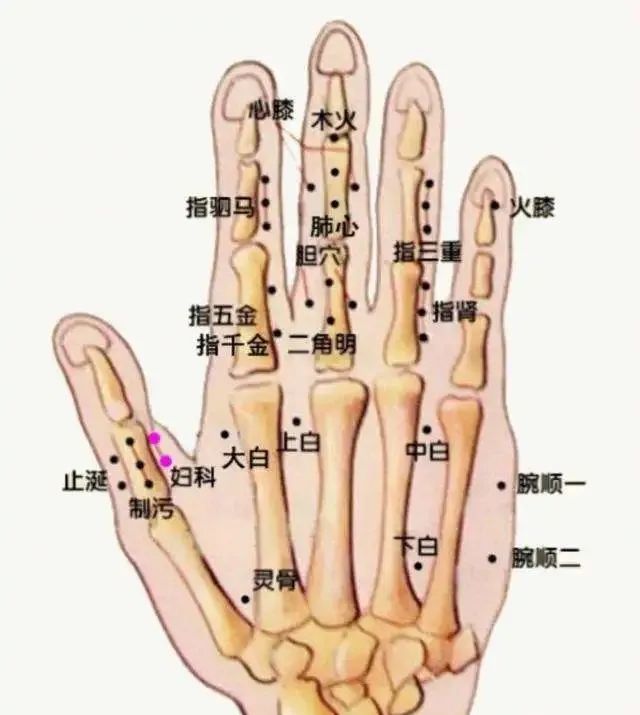
Gynecological Five Points
Location: On the back of the hand, on the outer side of the first phalanx of the thumb, starting from the transverse crease of the palm, each point is spaced two-tenths of an inch apart, totaling five points.
Anatomy: Contains the proper palmar digital nerve superficial branches, uterine nerve, and six fu organ nerves.
Needling: On the back of the hand, at the outer side of the first phalanx of the thumb, two and a half tenths of an inch from the center, spaced two-tenths of an inch apart, up to the second phalanx transverse crease, totaling five points.
Meridian: Enters the Ren and Du Meridians.
Point Characteristics: Regulates the Ren and Du Meridians, facilitates the lower jiao.
Indications: Uterine tumors, uterine cancer, uterine inflammation, ovarian inflammation, infertility, menstrual pain, irregular menstruation, excessive or insufficient menstruation, vaginal pain and swelling, red or white discharge, postpartum wind syndrome (postpartum wind syndrome).
Needling Method: Use a five-millimeter needle, directly insert two to three millimeters, or use a three-edged needle for shallow bloodletting.
Sensation: Localized aching and distending pain.
Application: The gynecological five points are particularly effective for women’s ailments. Clinically, any two to three points can be selected for needling, yielding instant results.
Explanation:
(1) The gynecological five points are the main points for treating women’s ailments and are essential points for gynecological treatment. They can be combined with other points such as Feng Chao and Mu Fu for better results. This point combined with Men Jin point is particularly effective for menstrual pain.
(2) In Dong Gong’s book, there are two points, while Master Hu added three points, totaling five points. I believe that in this area, selecting three points for needling is sufficient.
5. Si Ma Point for Allergic Rhinitis and Various Skin Diseases
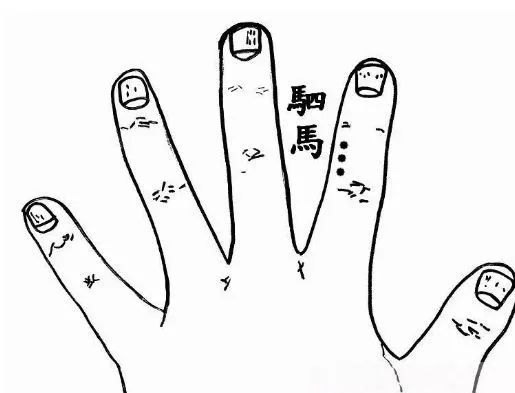
Si Ma Point
Location: Si Ma Er Point is located three-tenths of an inch outward from the center of the second phalanx of the index finger.
Si Ma Yi Point is located two and a half inches below Si Ma Er Point.
Si Ma San Point is located two and a half inches above Si Ma Er Point.
Anatomy: Contains the superficial branches of the median nerve, branches of the lung nerve.
Needling: Same as the acupoint.
Meridian: Enters the Lung Meridian.
Point Characteristics: Dispels wind and releases the exterior, harmonizes qi and blood.
Indications: Skin diseases, facial pigmentation, freckles, rhinitis, tinnitus, otitis media, chest pain, pleurisy.
Needling Method: Directly insert one to two inches.
Sensation: Localized aching and distending pain.
Explanation: The Si Ma Point is aligned with the Wu Jin Point and Qian Jin Point on the same line. The Wu Jin Point is on the first phalanx of the index finger, while the Si Ma Point is on the second phalanx. Dong Gong’s original text states to open two-tenths of an inch, while Hu’s text states three-tenths of an inch, which is the difference between the two.
Experience: The Si Ma Point has both hand and foot Si Ma points, both of which enter the Lung Meridian and are the main points for regulating qi, primarily treating skin-related issues. They are effective for various skin diseases, acne, and pigmentation.
Pairing Points:
(1) For treating pigmentation, pair Si Ma Point with San Huang, Tong Guan, and Tong Shan for better results.
(2) For treating inflamed large acne, this point can be paired with San Chong Point.
Use bone-needling and San Huang for various bone spurs.
6. Tong Guan, Tong Shan, and Tong Tian Combined with Bloodletting Needle Method for Treating Viral Myocarditis
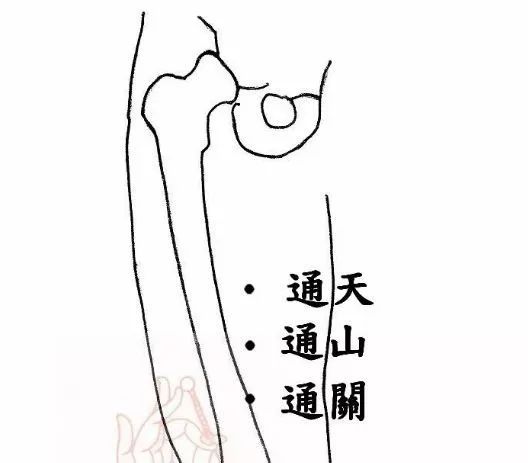
Tong Guan Point: Located on the midline of the thigh, five inches above the knee crease.
Tong Shan Point: Located two inches above the Tong Guan Point on the midline of the thigh.
Tong Tian Point: Located four inches directly above the Tong Guan Point on the midline of the thigh.
Indications: Heart disease, pericarditis (chest pain), pain on both sides of the heart, rheumatic diseases originating from the heart, dizziness, blurred vision, palpitations, stomach diseases, limb pain, cerebral anemia.
Needling Method and Application: Needle depth of five to fifteen millimeters. Tong Guan, Tong Tian, and Tong Shan points are generally each needled one to two points. For patients with hypertension, only one point should be needled on each foot.
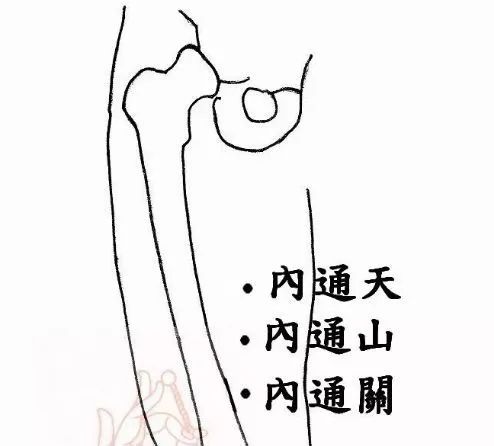
Nei Tong Guan Point: Open five millimeters inward from the Tong Guan Point.
Nei Tong Shan Point: Open five millimeters inward from the Tong Shan Point.
Nei Tong Tian Point: Open five millimeters inward from the Tong Tian Point.
Indications: Hemiplegia, limb weakness, limb nerve paralysis, heart failure, stroke with speech impairment, back pain and weakness caused by heart dysfunction, limb weakness.
Needling Method and Application: Needle depth of five to fifteen millimeters. Nei Tong Guan, Nei Tong Shan, and Nei Tong Tian points are used together, forming a straight three-needle method.
7. Lower San Huang for Diabetes
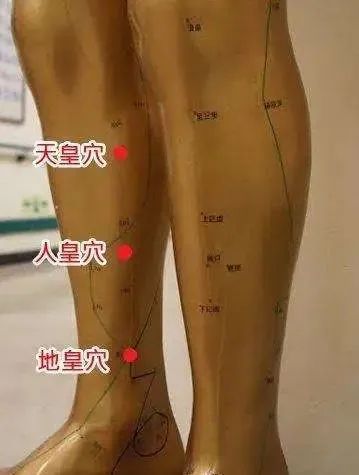
Tian Huang Point
Location: Bend the knee, one inch below the inner condyle of the tibia. This is one inch below the Yin Ling Quan point of the fourteen meridians.
Meridian and Anatomy: Lies over the nerves, renal nerves, six fu organ nerves, and branches of the heart nerve.
Needling: Located one inch below the inner edge of the tibia at the knee. This is one inch below the Yin Ling Quan point of the fourteen meridians.
Meridian: Enters the Heart and Kidney Meridians.
Indications: Excessive stomach acid, gastroesophageal reflux, nephritis, diabetes, protein in urine, cystitis.
Needling Method: Directly insert five to fifteen millimeters.
Sensation: Aching, distending, and electric sensation.
Note: Pregnant women should not be needled. Moxibustion is also not recommended.
Identification: The correct location of the Tian Huang point is one inch below the Yin Ling Quan point of the fourteen meridians, not the Yin Ling Quan point itself. Do not confuse them to avoid affecting the results, as the indications for Yin Ling Quan and Tian Huang differ. Readers should compare them themselves.
Application: This point, paired with the Tian Huang auxiliary point, treats gastroesophageal reflux and excessive stomach acid.
Experience: This point has reaction points on both sides of the neck near the supraclavicular fossa. Using pressure techniques can relieve pain in the neck area.
Pairing Points:
(1) For neck sprain pain, this point can be paired with the Wan Shun San point (near Hou Xi), combined with guiding qi needle techniques, generally yielding immediate results. If the effect is not apparent, bloodletting can be performed at the pain point.
(2) For shoulder pain, this point or the Shen Guan point can be paired with the Jian Ning point (located between the San Jian points), and if bloodletting is performed at the pain point, the effect is particularly good.
Ren Huang Point
Location: On the inner edge of the tibia, three and a half inches above the inner ankle bone. This is five-tenths of an inch above the San Yin Jiao point of the fourteen meridians.
Anatomy: Lies over the nerves, renal branch nerves, and lung branch nerves.
Needling: Located three and a half inches above the inner ankle bone. This is five-tenths of an inch above the San Yin Jiao point of the fourteen meridians.
Meridian: Enters the Lung and Kidney Meridians.
Point Characteristics: Harmonizes blood, relaxes tendons, tonifies the kidney and benefits essence.
Indications: Gonorrhea, impotence, premature ejaculation, nocturnal emissions, lumbar spine pain, neck pain, dizziness, hand numbness, diabetes, hematuria (blood in urine), pyelonephritis, kidney deficiency-related low back pain, back pain.
Needling Method: Directly insert six to fifteen millimeters.
Sensation: Aching, distending, and electric sensation.
Application: This point has a strong effect on enhancing sexual function and can be used as an anesthetic point during gallbladder and spleen surgeries.
Note: This point promotes uterine contractions, so pregnant women should not be needled.
The location of this point is five-tenths of an inch above the San Yin Jiao point, do not confuse them. San Yin Jiao is primarily for gynecological issues, while Ren Huang enters the kidney.
Experience:
(1) The Lower San Huang point combined with the San Cha Yi point, and then bloodletting at the Wu Xing point can enhance vision. Additionally, bloodletting at the Wu Xing point can treat symptoms of seeing floaters.
(2) Cosmetic acupuncture, combining the Upper San Huang with the Lower San Huang, Si Ma Point, and Ling Gu Point, has significant effects on facial beauty.
(3) The Lower San Huang can be needled together in a straight line, regulating the entire body and the three jiao, and can be used as a maintenance and health-preserving technique.
8. Zhi Wu Point for Chronic Ulcers That Won’t Heal
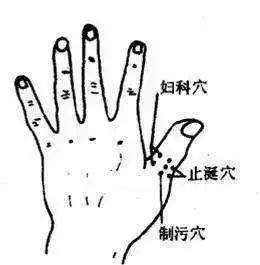
Location: The center of the back of the thumb, at the first phalanx, three points in total.
Indications: Chronic ulcers, malignant tumors after surgery that bleed continuously and do not heal.
Needling Method and Application: Use a three-edged needle to draw out black blood for immediate effect.
9. San Cha Point Combined with Zu San Chong for Deafness

San Cha Yi Point
Location: At the center point of the fork between the index and middle fingers.
Anatomy: Contains the superficial branch of the radial nerve, lung branch nerve, and renal nerve.
Needling: Located at the center point of the fork between the index and middle fingers.
Meridian: Enters the Kidney Meridian.
Indications: Keratitis, eye pain, low back pain, sciatica, brow pain, swelling pain, optic nerve atrophy, hemiplegia, atrophy.
Needling Method: Directly insert two inches. Insert the needle from the fork to the space between the two metacarpal bones. Insert the needle from the fork after making a fist.
Sensation: Localized aching, distending, and electric sensation.
Distinction: Although Dong’s San Cha point is the same as the Eight Evils point, the symptoms treated and the needling methods are completely different. The Eight Evils point uses a three to five millimeter needle or a three-edged needle for bloodletting. In contrast, Dong’s San Cha point is directly inserted two inches, which is different from the Eight Evils point. Readers should carefully distinguish.
Explanation: The San Cha Yi, San Cha Er, and San Cha San points are not listed in Dong Gong’s book, but were included by Master Hu in his compilation of Dong’s practical acupuncture points. The San Cha points are key points passed down by Dong Gong that have remarkable effects. There are three San Cha points, each with different meridian connections, and they have the function of adjusting and tonifying, making them frequently used key points by Dong Gong.
San Cha Er Point
Location: At the center point of the fork between the middle and ring fingers.
Anatomy: Contains the ulnar nerve dorsal branch, spleen nerve, and liver branch nerve.
Needling: Located at the center point of the fork between the middle and ring fingers.
Meridian: Enters the Spleen and Liver Meridians.
Point Characteristics: Strengthens the spleen, activates the collaterals, and promotes blood circulation.
Indications: Pancreatitis, splenomegaly, hemiplegia, sciatica, numbness of hands and feet, liver weakness.
Needling Method: Directly insert two inches. Insert the needle from the fork to the upper edge of the metacarpal bone. Insert the needle from the fork after making a fist.
Sensation: Localized aching, distending, and electric sensation.
Distinction: Although this point is located the same as the Eight Evils point, the symptoms treated and the needling methods are different. Please pay attention to the distinction.
Experience:
(1) The San Cha Yi, San Cha Er, and San Cha San points, when needled together, greatly assist in recovering physical strength during colds. The San Cha points, like Dong’s extraordinary points such as Shen Er Point, Shui Jin Shui Tong, and Tong Kidney Point, have tonifying functions, not only treating diseases but also tonifying qi and blood. Individuals with a weak constitution can use Shen Er Point and San Cha points for needling.
(2) Each San Cha point has its own meridian connection, and when used clinically, it is best to combine with palm diagnosis to select the appropriate meridian points for better results.
San Cha San Point
Location: At the center point of the fork between the ring and little fingers.
Anatomy: Contains the ulnar nerve dorsal branch and renal nerve.
Needling: Located at the center point of the fork between the ring and little fingers.
Meridian: Enters the Kidney Meridian.
Point Characteristics: Nourishes the kidney, relieves pain, and promotes diuresis.
Indications: Dizziness, sciatica, bone spurs, low back pain, kidney pyelonephritis, kidney edema, severe colds.
Needling Method: Directly insert two inches. Insert the needle from the fork to the upper edge of the metacarpal bone. Insert the needle from the fork after making a fist.
Sensation: Localized aching, distending, and electric sensation.
Distinction: Although this point is located the same as the Eight Evils point, the symptoms treated and the needling methods are completely different.
Experience:
(1) The San Cha San point enters the Kidney Meridian, thus in the Five Elements theory, it belongs to Water. Since the liver is Wood and governs the eyes, nourishing the kidney can benefit the liver, hence needling the Kidney Water can nourish the liver Wood, which is very beneficial for the eyes.
(2) After needling the San Cha San point, it can also be paired with the Wan Shun Point to form Dong’s T-shaped needling method, further enhancing the effect.
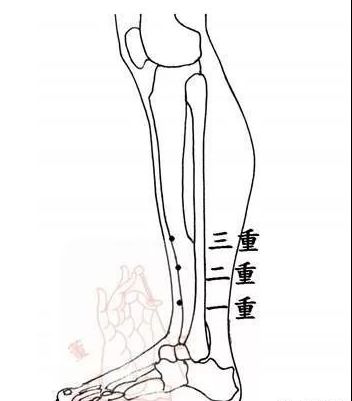
San Chong Point
Location: Two inches above the Er Chong Point.
Anatomy: Contains the superficial branches of the lateral sural nerve, branches of the heart nerve, and branches of the lung nerve, and spleen nerve.
Needling: Located two inches above the Er Chong Point.
Meridian: Enters the Heart, Liver, Spleen, and Lung Meridians.
Point Characteristics: Breaks qi, moves blood, and eliminates stagnation.
Indications: Same as the Er Chong Point.
Needling Method: Directly insert one to two inches. Use a three-edged needle for bloodletting.
Sensation: Localized aching, distending, and electric sensation.
Explanation: The Er Chong, San Chong, and San Chong points can be needled simultaneously, forming a straight needle method, which has the function of moving qi, breaking blood, and opening orifices, especially when paired with needling techniques, it can accelerate the therapeutic effect.
Experience:
(1) The gynecological points and San Chong points can be combined with Tian Ying needle techniques to treat uterine fibroids.
(2) The Jian Zhong, Jian Zhong, and Fen Zhi points combined with San Chong can treat breast tumors.
(3) The San Chong point, when paired with Di Zong Point and Mu Liu Point, can treat tongue stiffness and speech difficulties, as the San Chong point has a strong effect on the brain, which can improve brain cells.
(4) For lack of concentration and memory loss, needling the San Chong point can be beneficial.
(5) Bloodletting at the San Chong point can treat large neck lumps and prostate enlargement (requires pairing with the Zhi Da Jian, Wai Jian, and Jie Mei points).
10. Ce San Li and Ce Xia San Li for Trigeminal Neuralgia Have Remarkable Effects, Proven Time and Again
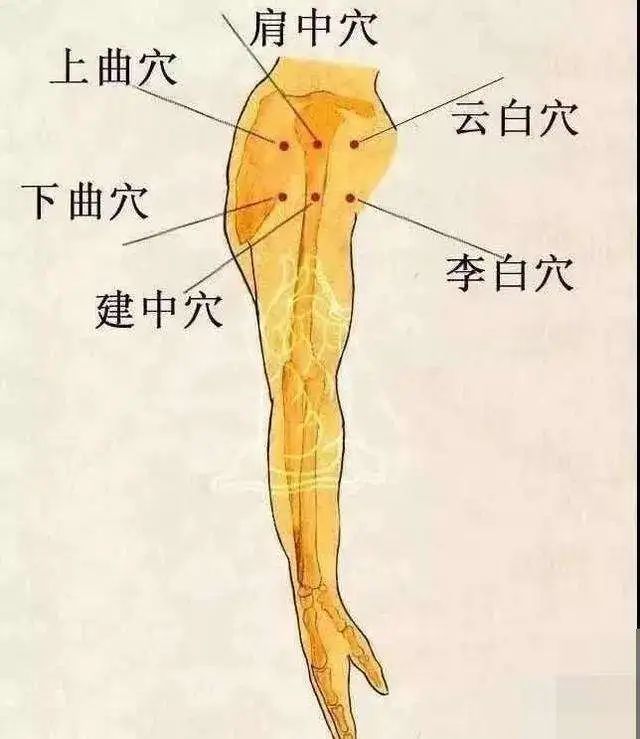
Location: Ce San Li point is located two and a half inches outward from the Si Hua Shang point, which is one and a half inches outside the foot San Li point of the fourteen meridians.
Anatomy: Contains the superficial branches of the lateral sural nerve, branches of the dental nerve, and branches of the lung nerve.
Needling: Located at the anterior edge of the fibula, two and a half inches outward from the Si Hua Shang point.
Meridian: Enters the Heart and Lung Meridians.
Point Characteristics: Invigorates blood, dispels stagnation, reduces inflammation, and relieves pain.
Indications: Toothache, facial nerve pain, trigeminal neuralgia, intercostal neuralgia, appendicitis pain.
Needling Method: Directly insert one to one and a half inches.
Sensation: Localized aching, distending, and electric sensation.
Experience: This point, along with Wai San Guan and San Chong points, can be referred to as the outer side of the lung area. If there are any discolorations or abnormalities in this area, bloodletting can be performed to treat head and facial issues, as well as lung and chest-related diseases.
Explanation: This point is effective for treating migraines, thyroid enlargement, and sublingual swelling, similar to the effects of the San Chong point. It can be alternated with the San Chong point and Si Ma Point for good results.
Pairing Points:
(1) Needling this point can be paired with the Si Hua point for bloodletting, which is effective for toothache.
(2) This point paired with Ling Gu and Xin Men points is effective for treating fullness.
(3) This point paired with San Chong can treat parotitis, and bloodletting can also be performed at the pain point.

